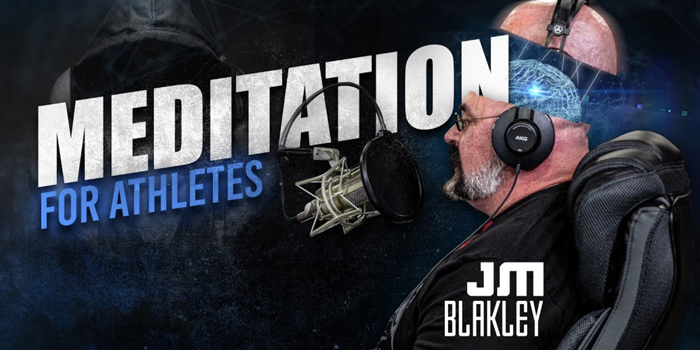
JM Blakley knows any coach on the planet could give him a breakdown of how much of a game is physical and mental. It’s never 100 percent physical. It could be 50-50 or 75-25 or 80-20 — in favor of mental.
The next question is what trips these coaches up: “How many hours a week do you spend with your athletes doing mental training?” The answer JM gets is usually zero. None. Nada.
The wild thing about that is the coach admitted the importance of the mental aspect of training, but they’re not doing anything about it.
“I would actually agree with some of them on some of the higher estimates of how much is mental. So a good place to start is to admit that we’re not doing nearly enough as coaches or as personal athletes training ourselves to work on this.”
Where should coaches and athletes start to work on the mental aspect?
JM recommends breathing exercises and/or meditation techniques. There are plenty of good ones out there — and JM isn’t sure if there are any bad techniques. He does note that meditation is not the magic bullet. It’s not a cure-all.
“Meditation is like a drink of water. You’re thirsty. You drink a little bit, and you feel better. Then you get thirsty again, and that’s what meditation’s like.”
It helps relieve tension, but someone is always going to get stressed again, so you’ll meditate to help relieve some of that again.
Although JM has a few preferred meditation techniques, he reminds listeners that everyone is different. What works for one person won’t work for another.
He suggests starting with a Tibetan-style meditation, in which you sit and do nothing. You shut down and don’t move a muscle — just breathing. Focus on the breathing for five minutes to start and work your way up to 15 minutes. Maybe an hour, though 15 minutes is an excellent amount of time for unplugging from the rest of the world.
Dave Tate then asks JM what athletes should do with their minds in this style of meditation.
Luckily, the Tibetans have an answer to this, as JM explains:
“As you’re concentrating on your breathing and a thought pops, bubbles up, from your subconscious: ‘I’ve gotta get milk today.’ They [the Tibetans] say, ‘Don’t add to it’ because what we do is take a thought and add another thought to that. ‘I’ve gotta get milk today. While I’m there, I’ll stop to get some other stuff, too.’ And you start to think about it: ‘Well, no, I’m not supposed to thinking about that. What am I supposed to be thinking about?’ Nothing. You start having this conversation again.”
Rest assured, your first few Tibetan-style meditations may very well be spent thinking thoughts and trying to get to spaces between thoughts. You will slip up, which is why it takes practice. Don’t judge yourself too harshly for that. You’ll end up continuing the conversation with yourself and putting yourself down.
Just like preparing for the physical side of a game, the mental aspect takes a lot of hard work. But if you train yourself to meditate regularly, it’ll get better and quieter — and your mind gets quieter, too. It’s a rest for your mind.
It’s also a rest for your body, which technically never really rests when you take into account your breathing and heartbeat. Meditation is a different kind of rest for your body.
“If you really want to rest your mind, take some time. Sit. Do nothing. Just be. What would it be if I didn’t have to do anything? Like if I didn’t even have to sit. Or if I didn’t even have to breathe. But I’m going to do as little as possible and be as much as possible. I’m going to be instead of do. We’re always thinking about what we’ve got to do. Thinking is something we do. What if you stopped thinking? What if you just be? What if you just existed and that was all you had to do? That could be very freeing and very renewing.”
Another meditation exercise JM likes is a breathing technique: three breaths in a minute. This requires a 10-second inhale, followed by a 10-second exhale. That’ll add up to three breaths in a minute. See if you can do that for three minutes. It’s slow, but it can be done, and it calms you down.
Then there’s visualization: seeing the goal clearly, which is a technique Dave is very familiar with and has used with the people he trains.
“With visualization, you first start the visualization, you’re doing to see some weird-ass shit. You visualize a bench press, and all of a sudden, you’re twirling it and it goes flying up in the air on fire... to me, it was an extremely valuable school I was taught in high school. I was actually part of a floatation tank grader experience [like a deprivation chamber]. I was taught with a candle to focus on the candle until the candle goes and to put yourself in the deep state, and then begin the visualization. It took weeks before things could be black and white, then more weeks before things could be vivid color, and then I could actually see and do what I wanted to do.”
It was a three-month-long process before Dave could finally see what he wanted to see. Dave says that some people believe that they’ll close their eyes to visualize what they want to see and that it’ll be like a movie screen in front of them. But it’s not, so they say they can’t do this.
On the other hand, JM completely disagrees with this. He tells people to start with daydreaming — everyone knows how to do it. We all know how to do that, so start with that. Daydream about going to that upcoming meet in Florida. With daydreaming, there’s no pressure. It’s generally positive, which is something that people in what JM calls “the visualization community” stand by. If you start visualizing something negative, you stop and start over. Positive thoughts only.
Negative thoughts are still pervasive, and there are other ways to get those out of your mind. JM says he’d imagine putting the negative thoughts in a box, close the box, and send it over Niagara Falls, and watch it fall.
“That sounds silly, right? But guess what? Your subconscious is a little kid. It’s not this sophisticated consciousness we operate with. And I believe, by the way, it’s a bigger part of us.”













